Exploring Souk Naif Deira: A Comprehensive Guide
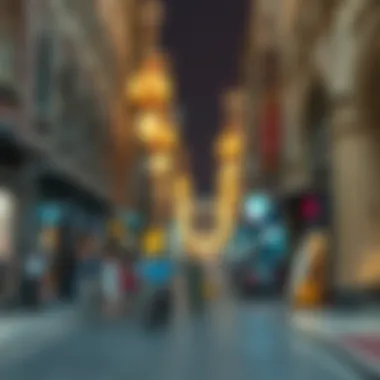

Intro
Nestled in the heart of Deira, Souk Naif stands as a vibrant testament to Dubai’s cultural tapestry. This marketplace, often overshadowed by the glitz of modern shopping malls, offers a unique glimpse into the rich traditions and commerce that have shaped the emirate. For both locals and travelers, exploring Souk Naif isn’t just about shopping; it’s an experience steeped in history, community, and authenticity.
As you wander through the bustling alleys of the souk, the palpable energy of exchanging goods and stories fills the air. From the aroma of spices wafting through the narrow lanes to the strikingly intricate textiles hanging from stalls, Souk Naif is a microcosm of Dubai's past and present. Whether one is looking to invest, buy, or simply soak in the atmosphere, this guide aims to unveil the many layers of Souk Naif while offering practical insights for navigating its offerings.
Market Trends
Understanding the current trends within Souk Naif is pivotal for potential investors or those looking to tap into the local market’s dynamics. Amid rapid urban development, the essence of Souk Naif remains unchanged, yet, it adapts to the evolving landscape in nuanced ways.
Current Property Trends
As the heart of historical commerce in Dubai, Souk Naif has witnessed shifts that align with broader market trends. Property values in Deira, including the vicinity of the souk, have shown an upward trajectory. The rise in demand for retail spaces has prompted landlords to modernize their offerings while preserving the traditional charm of the souk. Many small shops, catering to diverse clientele, thrive alongside the contemporary framework that retailers are slowly adopting.
Some factors influencing current property trends include:
- The increasing foot traffic brought on by tourism and local shoppers visiting the souk.
- Enhanced connectivity via new transport links which have made accessibility easier.
- The government’s initiatives to revitalize heritage markets, juxtaposed with commercial interests.
Emerging Neighborhoods
The neighborhoods surrounding Souk Naif are also evolving, drawing interest from investors and residents alike. Areas like Al Rigga and Al Muraqqabat are seeing a renaissance of sorts, with a fresh influx of eateries, boutiques, and art spaces.
Key aspects to take note of:
- The blend of old and new, where traditional markets stand alongside upcoming cafes and art exhibitions.
- Increasing demographic diversity, making Deira a melting pot of cultures.
- The government’s push for sustainable developments in the area, which may open doors for eco-conscious investors.
"Investing in Deira's charm is not just about profit; it's about preserving its soul while embracing change."
Investment Insights
For potential investors looking at Souk Naif as an opportunity, it’s essential to equip oneself with relevant insights.
Investment Strategies
When considering investments in the domain of Souk Naif and Deira at large, taking a multifaceted approach is advisable. Investors should focus on understanding customer behavior, market demands, and unique selling points of the area. The growing trend towards experiential retail can’t be overlooked; therefore:
- Assessing foot traffic during different times of the day can provide insight into optimal business hours.
- Collaborating with local artisans and businesses can augment authenticity and attract a loyal customer base.
- Exploring partnerships with cultural events can not only diversify offerings but also increase visibility, presenting opportunities for growth.
Legal Considerations
Navigating the legal landscape of property and business investments in Dubai can be intricate, thus it is prudent to stay informed. Key considerations include:
- Understanding the regulations regarding foreign ownership in retail markets.
- Familiarizing oneself with local codes of conduct for businesses, especially in heritage-rich areas.
- Engaging with legal advisors who specialize in real estate to ensure compliance with regulatory frameworks.
In essence, as one traverses the alleys of Souk Naif, the intricate dance between tradition and modernity becomes evident. Embracing this balance not only enriches the experience of being in the souk but also lays the foundation for savvy investment strategies.
Historical Context of Souk Naif
Understanding the historical context of Souk Naif is essential for grasping its essence today. This souk, steeped in tradition and cultural richness, paints a vivid picture of Dubai's past and its evolution through time. The very bricks and stalls of Souk Naif whisper tales of yesteryear, telling us about a vibrant trading hub that has not just withstood the test of time but thrived amidst the hustle and bustle of modernity. The history of Souk Naif is not just a recounting of events; it is a crucial thread in the fabric of Dubai’s identity, providing insights into cultural exchanges and social dynamics that have shaped the city as we see it.
Origins and Development
The origins of Souk Naif trace back several decades when it began as a modest marketplace catering primarily to locals. Initially, this souk served as a gathering place facilitating trade, commerce, and social interactions among the residents of Deira. The area's strategic location along the Dubai Creek made it a natural choice for merchants dealing in spices, textiles, and handicrafts.
As the city blossomed and became a hub for commerce, Souk Naif developed in parallel, adapting to changing economic conditions and the influx of international traders. The mid-20th century witnessed a notable surge in trade due to the oil boom, which brought not only wealth but also a diversified population. This influx added new layers to the souk's offerings, transforming it from a local bazaar into a melting pot of cultures.
Through the years, continued investments in infrastructure have maintained the growth trajectory of Souk Naif, ensuring that it remains relevant. Renovations and modern adaptations made to the structure have enhanced the experience while preserving its historical context. Today, as visitors stroll through its bustling alleys, they encounter a blend of the old and the new—a monument to Dubai’s resilient spirit.
Cultural Significance
Souk Naif holds profound cultural significance, acting as a beacon of heritage and community. It is a living archive where locals and tourists alike experience the rich traditions of the Emirati way of life. The souk is more than just a shopping destination; it embodies the customs, stories, and interactions that define the community.
For Emiratis, this market is a forgotten but still cherished spot to buy traditional garments, intricate jewelry, and aromatic spices, all of which tell tales of familial heritage and culinary practices. Langauge and dialects paint the air, capturing the soundscape of multicultural coexistence.
Moreover, the presence of various stalls showcasing regional crafts fosters a sense of pride among local artisans, promoting the preservation of heritage crafts that might have been lost over time. The cultural vibrancy is not only evident in commerce but also resonates through periodic events like local festivals and exhibitions that are organized, further enriching the atmosphere of interaction.
"Souk Naif is a living testament to our history, culture, and identity, reflecting how far we have come while keeping our roots intact."
In essence, Souk Naif transcends its role as a marketplace; it serves as a symbol of connectivity—between the past and present, the local and the global. Through the lens of its historical context, one can appreciate the rich tapestry of experiences that Souk Naif offers to all who venture here.
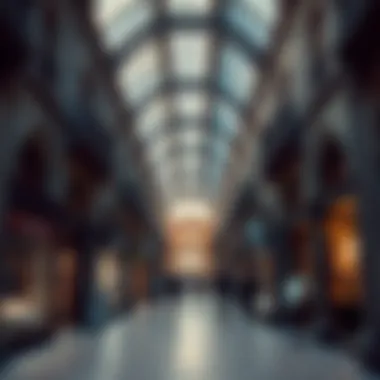

Architectural Features
The architectural landscape of Souk Naif not only reflects the heritage of Dubai but also showcases a blend of tradition and modernity that is essential to understanding its appeal. The unique structural elements found within the souk provide insight into the cultural practices and social dynamics that continue to thrive in this historical marketplace. This section will explore the significant architectural features that make Souk Naif a key location in Deira, especially for investors, realtors, buyers, and analysts looking to comprehend the market's character.
Traditional Middle Eastern Design
Within the vibrant fabric of Souk Naif, traditional Middle Eastern design takes center stage. Elegant archways and intricate wooden doors narrate tales of a time when craftsmanship was sacred. The color palette often reflects the desert hues—tans and browns with splashes of vibrant colors accentuated by textiles that are themselves artworks.
- Open Layout: The souk's design is characterized by its open-air layout, enabling smooth airflow—an essential quality in the High temperature of Dubai. This encourages leisurely strolls among vendors, promoting an inviting atmosphere for commerce, which is integral to the economy.
- Material Use: Predominantly made with local materials such as limestone and coral stone, these buildings withstand time, embodying durability and resilience. Artisans once chased the sun while crafting their goods, solidifying the connection between the architecture and the people who built it.
Visitors marvel at the historical preservation efforts that have retained the essence of local craftsmanship. These designs inspire a sense of belonging and continuity, captivating anyone who enters the market. In knowing this, potential investors can appreciate the intrinsic value of such heritage, which often translates into economic potential
Modern Adaptations
As with any evolving marketplace, Souk Naif is not immune to the winds of change. Recent architectural adaptations reflect modern influences without overshadowing the past, illustrating a society that respects its roots while embracing innovation.
- Infrastructure Enhancements: Renovations have introduced necessary infrastructure improvements while retaining the inherent charm. Newer lighting solutions, for instance, enhance visibility at dusk, keeping the souk vibrant long into the evening while making it safer for patrons.
- Sustainable Practices: The implementation of eco-friendly practices is gaining traction, such as energy-efficient air conditioning methods and waste management systems. These changes resonate well with today’s environmentally-conscious investors who prioritize sustainable developments.
- Retail Spaces: Retail establishments have been designed with a balance that respects traditional aesthetics. Many shops blend contemporary glass storefronts with culturally relevant design elements to create a harmonious shopping experience.
The modernization of Souk Naif serves a dual purpose; it appeals to tourists while supporting the local economy by attracting a more diverse clientele.
In sum, the architectural features of Souk Naif weave together a narrative that is both historical and contemporary, offering insight into Dubai's evolving identity. This duality is critical in gauging the market's future, where timeless appeal and modern convenience can create a lucrative investment framework.
Shopping Experience at Souk Naif
The shopping experience at Souk Naif is more than just a transaction; it's an immersion into the vibrant tapestry of Dubai's rich culture. Strolling through its bustling aisles, you will find a treasure trove of goods that reflect the essence of the Middle East. The sights and sounds are both captivating and educational, making it an essential part of any visit to Dubai. Shoppers here not only browse but also engage with a history that is woven into each strand of fabric and each figurine.
When it comes to shopping at Souk Naif, it’s the personal connections that truly stand out. Local vendors, often with years of experience, share stories about their products, creating a unique bond between the buyer and the seller. This atmosphere underlines the importance of understanding not just what you want to buy, but also the stories and traditions that come along with it.
Types of Goods Offered
Textiles
Textiles at Souk Naif are a feast for the senses. From colorful embroidered fabrics to luxurious silk shawls, these textiles reflect a blend of traditional craftsmanship and modern style. They play a pivotal role in the local economy, with many artisans creating unique pieces that tourists often take home as mementos. These textiles are more than just materials; they are a representation of the cultural heritage of Dubai. The beauty of these fabrics lies not just in their colors but in the intricate techniques used in their making. Shoppers appreciate that by choosing local textiles, they are supporting skilled artisans directly.
Key characteristics of textiles include:
- Variety: Whether it’s for home decor or fashion, you’ll find an array of options to match both personal taste and cultural significance.
- Authenticity: Each piece carries a story, often made by hand with techniques passed down through generations.
While textiles are a quintessential part of the market, one must consider that the price can vary significantly. It’s advisable to take the time to compare different stalls to find both quality and value.
Jewelry
Jewelry at Souk Naif captures the imagination of visitors with its intricate designs and vibrant colors. From gold pendants to silver bangles, the collection here has something for everyone. The unique aspect of local jewelry is the opportunity to find handcrafted items that reflect the artistic flair of the region, often adorned with precious stones and traditional motifs.
Key characteristics of jewelry include:
- Craftsmanship: Each piece is often designed and manufactured by local artisans, ensuring that buyers receive something truly unique.
- Cultural Significance: Much of the jewelry showcases Islamic art and symbolizes aspects of local culture.
For jewelry enthusiasts, the experience of purchasing a piece involves not only the shiny allure but also an emotional connection to the craftsmanship behind it. However, potential buyers should be prepared to negotiate, as prices can be inflated based on tourist interest.
Perfumes
Souk Naif is renowned for its diverse selection of perfumes, including traditional Arabic ouds, crafted from the finest ingredients. The perfume selection is more than a shopping experience; it’s about reviving old traditions. Visitors will find an array of fragrance options, fitting any preference from floral notes to strong, smoky aromas.
Key characteristics of perfumes include:
- Variety: Different types of fragrances are available, and you can often custom-blend your own.
- Tradition: Perfume-making is deeply entrenched in regional customs, and buying a scent can be transformative.
As lovely as the fragrances are, potential buyers should be mindful to inquire about the ingredients, particularly if they have sensitive skin. Testing scents before buying is a common practice in this souk, and it’s highly encouraged.
Spices
The spice section of Souk Naif is a sensory delight, where the air is thick with a medley of aromas that reflect the diversity of Middle Eastern cuisine. From turmeric to saffron, the range of spices available plays an essential role in culinary traditions, making them a must-try for anyone looking to bring a piece of local flavor back home.
Key characteristics of spices include:
- Freshness: Many vendors sell spices that have been sourced and stored with care, ensuring peak flavor.
- Educational Experience: Vendors often share knowledge about how to use each spice, enriching the shopping experience.
When purchasing spices, consider asking for recipe suggestions from the vendors. Unlike larger stores where you might find pre-packaged items, Souk Naif’s spices offer a chance for culinary experimentation in your own kitchen.
Interacting with Vendors
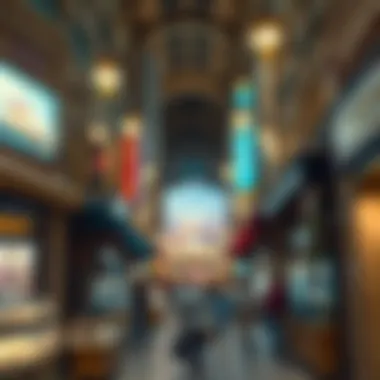
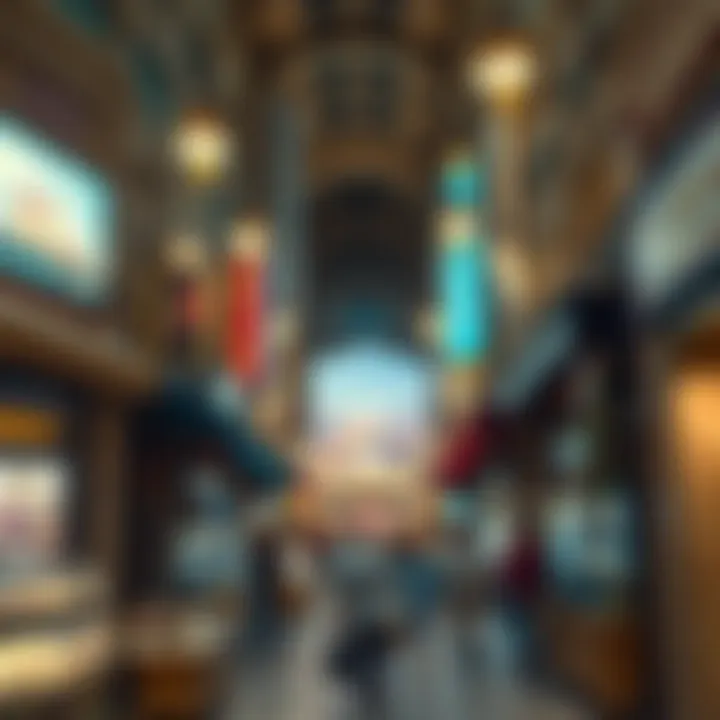
The charm of Souk Naif is illuminated during interactions with the vendors. They play a critical role in not just selling goods but also enhancing the overall experience. Engaging with them can provide deeper insight into the cultural significance of the products offered. Locals often have stories woven into the goods they sell, and taking the time to listen can enrich your understanding of what makes each item special.
Negotiating prices is customary, often adding a bit of flair to the shopping experience. Shoppers should feel comfortable asking about item origins and sharing their interests, as the vendors typically enjoy sharing their knowledge. Approaching a purchase with curiosity rather than just as a transaction can yield a more memorable experience.
The Role of Souk Naif in Dubai's Economy
Souk Naif stands as a vital cog in the bustling machinery of Dubai's economy. Its presence not only enriches the historical landscape of the city but also plays an essential role in enhancing economic activities that benefit both the local community and tourists alike. As an emblem of traditional commerce, Souk Naif illustrates how historical charm can coexist with modern economic needs, offering a unique blend that makes it a standout destination.
Tourism and Local Economy
Tourism significantly bolsters the local economy around Souk Naif. The souk acts as a magnet for local and international visitors seeking authentic experiences. Tourists flock to the market not just for shopping but to soak in the vibrant atmosphere that the souk offers. According to recent studies, tourist footfall in Dubai increased considerably due to its cultural landmarks, and Souk Naif is no exception.
The presence of local artisans and vendors enhances the shopping experience, creating a rich tapestry of cultural interactions. Visitors find themselves immersed in local traditions, negotiating prices for textiles, jewelry, and spices amidst the hustle and bustle of daily life. This not only preserves the essence of traditional commerce but also supports local economies by providing livelihoods for countless families.
Moreover, this influx of tourists translates directly into increased revenue for local businesses. A thriving market contributes to the overall economic stability of Deira, where small-scale entrepreneurs can flourish. These businesses often operate on tight margins, and the consistent demand from both locals and tourists helps them to sustain their livelihood.
“Souk Naif isn’t just a place to shop; it’s a microcosm of Dubai’s ability to merge tradition with modern economic dynamics.”
Market Competitiveness
In the ever-evolving marketplace of Dubai, Souk Naif holds its ground as a unique shopping center, significantly contributing to its competitive edge. Unlike modern megamalls, Souk Naif offers an authentic experience rooted in cultural heritage. This distinct atmosphere draws in a particular niche of consumers who value heritage alongside quality and authentic interaction.
Vendors at Souk Naif often emphasize unique selling points that differentiate them from larger competitors. Handcrafted items, personalized service, and local knowledge elevate each purchase; buyers frequently leave with not just products but stories and connections, which is something mass market retailers often lack. This personal touch enhances customer loyalty, allowing smaller vendors to thrive even amidst competition from larger retail chains.
Furthermore, the competitive pricing found within the souk keeps it attractive for bargain hunters. The traditional bargaining culture offers savvy shoppers the chance to negotiate, resulting in better deals and memorable experiences. This approach stands in stark contrast to the fixed-price models common in larger retail settings, allowing Souk Naif to offer a more participatory shopping experience.
In summary, the economic impact of Souk Naif extends far beyond its borders. It plays a crucial role in driving tourism, supporting local businesses, and enhancing the cultural fabric of Dubai's economy. As the larger market ecosystem evolves, Souk Naif provides a unique and valued component, allowing both visitors and locals to engage with the heritage of Dubai in a meaningful way.
Visitor Information
Understanding the visitor information for Souk Naif is crucial for anyone planning to explore this iconic market in Deira, Dubai. Knowing where to go and when to visit can greatly enhance the experience, whether you're a tourist hunting for unique treasures or an investor seeking potential opportunities.
Location and Accessibility
Souk Naif rests in the heart of Deira, easily reachable by various transport options. For those relying on public transit, the nearest metro stations are Al Rigga and Union, both just a short stroll away. Buses frequent the area, making it convenient for locals and visitors alike.
Driving? Parking is available, but be sharp-eyed; the streets can be busier than a hive of bees, particularly during peak hours. It’s wise to plan your journey with ample time so you’re not darting around like a cat on a hot tin roof trying to find a spot.
Walking through the vibrant streets leading to the souk adds to the experience, enriching visitors with colorful sights and sounds. Additionally, taxis are a common choice, though being aware of the local traffic patterns can save you some headache.
Best Times to Visit
Timing your visit to Souk Naif can make a world of difference. The souk is generally buzzing with activity, but depending on what you’re after, your ideal visit might vary.
For those seeking a quieter experience, early mornings are a gem. You can wander through the market without too many people crowding in. However, if you want to soak up the lively atmosphere, late afternoons and evenings are lively, filled with sounds of haggling and the rich scents of spices wafting through the air. Plus, the evenings often come with cooler temperatures, making it a delight to walk around.
Here are some considerations for your visit:
- Avoid the peak summer months. The heat can be quite oppressive, making the experience less enjoyable.
- Check for local holidays or events. These periods can bring larger crowds, providing a more festive feel at the cost of comfort.
- Timing for food vendors. Many stalls put out fresh goods in the morning, so there's a benefit to visiting early if local delicacies engage your taste buds.
Ultimately, plan based on your goals—whether it’s quiet exploration or an energetic dive into the market buzz, picking the right time is half the battle.
Key Takeaway: Make use of public transport and visit during off-peak hours for the best experience at Souk Naif.
For more about navigating Dubai's public transport system, visit RTA Dubai.
Navigating Souk Naif
Navigating Souk Naif is akin to unraveling a tapestry of authentic experiences woven with the threads of Dubai's vibrant cultural landscape. This bustling market doesn't just offer goods; it provides an insight into the life and heritage of the local community. Understanding how to maneuver through this lively maze can enhance the visit, allowing shoppers to uncover hidden treasures and engage with the rich traditions that the souk embodies.
Payment Methods
When you step into Souk Naif, it's essential to recognize the diverse ways of conducting transactions to keep your shopping experience as smooth as butter. While many vendors do accommodate card payments, cash remains the king in this traditional marketplace. Here’s what you should know about payment methods:
- Cash is Preferred: Vendors often prefer cash transactions, especially for smaller purchases. Be sure to have ample local currency, Dirhams, handy.
- ATM Availability: There are ATMs nearby, but it's wise to withdraw cash before diving into the shopping frenzy. This can prevent any frustration when you find that perfect handmade scarf or exotic spice but are short on change.
- Currency Exchange: Take note that exchange services might not be available within the souk, so plan ahead to avoid any currency hiccups during your visit.
Engaging in casual chats with the vendors not only enhances your shopping journey but could also lead to getting the best prices.
Bargaining Culture
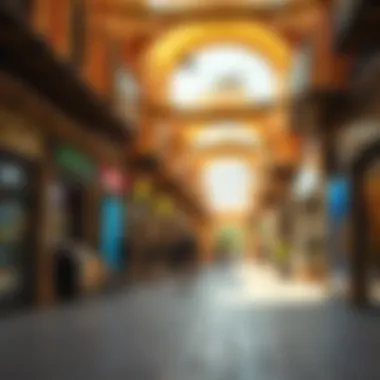
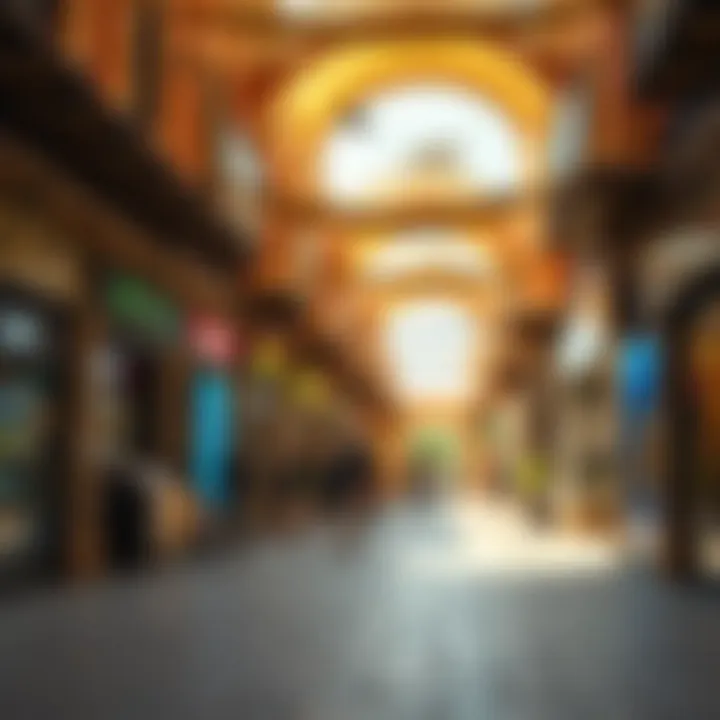
Bargaining is not just a practice but an art form steeped in the cultural fabric of Souk Naif. If you're stepping in thinking of paying full price, you might as well be bringing a knife to a gunfight. Here, haggling is both a ritual and a means of establishing rapport between buyer and seller. The following pointers will make you a savvy negotiator:
- Start Low: When bargaining, begin with a price lower than what you intend to spend. This gives you room to negotiate and allows the vendor to counteroffer without feeling insulted.
- Show Interest: Spend time engaging with the products and vendors. This personal touch can lead to better deals, as sellers appreciate genuine interest.
- Know When to Walk Away: Sometimes, if the price doesn't feel right, simply stating your intention to walk away can prompt the seller to reconsider. It's a classic tactic that often works wonders in this souk environment.
"Bargaining is not just about getting a lower price; it’s about the experience and the stories shared in the process."
In summary, knowing how to navigate payment methods and the nuances of the bargaining culture will greatly enhance your experience at Souk Naif. It will not only allow you to make informed decisions but also immerse you deeper into the lively atmosphere that makes this souk a gem within Dubai.
Culinary Offerings
When wandering through the vibrant pathways of Souk Naif, one cannot overlook the rich tapestry that is woven by its culinary offerings. Food is not merely fuel; it serves as a cultural bridge. The souk's food scene embodies the spirit of Dubai's diverse community, featuring a blend of local flavors and international cuisines that reflect the city’s multicultural identity. For visitors, indulging in these culinary delights is as essential as visiting its shops. The flavors encountered here contribute not only to a memorable experience but also to a broader understanding of the cultural context that defines the souk.
Local Delicacies
In the bustling corridors of Souk Naif, local delicacies stand as a testament to traditional Emirati cuisine. Harees, a dish made from wheat and meat slow-cooked into a porridge, is oftentimes associated with celebrations and gathering, echoing the communal spirit of the region. Then there’s Shawarma, a street food icon, available with marinated meats slathered in tantalizing sauces, all wrapped snugly in pita bread.
Knafeh, a sweet cheese pastry soaked in syrup, showcases a delightful dichotomy of textures and is often enjoyed as a dessert at the end of a meal. These treats not only tantalize your taste buds but are also conversely tied to the rich values of hospitality in Emirati culture. To truly appreciate Souk Naif, digging into its local dishes reveals the stories of the people and traditions that shape its identity.
Dining Options Nearby
After delving into the stalls and pampering your senses with the delightful local cuisine, exploring nearby dining options provides an extended experience of culinary adventure. Just around the corner, establishments like Al Mallah serve up some of the most famous shawarmas in the area. Equally compelling is Al Iwan, where traditional dishes are served in an ambiance that reflects the warmth of Emirati hospitality.
For those seeking something more international,
- Ravi Restaurant is known for its cross-cultural menu, often drawing in food enthusiasts of various backgrounds.
- Bistro Chez P.V delivers a fusion of French and Middle Eastern flavors, enchanting diners with innovative takes on classic dishes.
Each of these spots invites diners to savor meals curated from the freshest of ingredients, showcasing the region’s dedication to culinary excellence.
"In every bite, one can taste the love and labor of the people who call this place home.”
Understanding the importance of these offerings enriches your experience at Souk Naif; it’s not just a shopping destination but a vibrant cultural hub where flavors tell stories. Whether indulging in traditional dishes or exploring diverse dining options, your taste journey in Souk Naif will linger in your memory well after you've left.
Community Events and Cultural Activities
Community events and cultural activities at Souk Naif play a crucial role in infusing life into this historic marketplace. They not only reinforce the cultural heritage of the region but also foster community spirit among residents and visitors alike. Engaging with local traditions through these events provides a unique insight into the fabric of Emirati society, which is especially beneficial for investors and analysts looking to understand the local market dynamics.
Seasonal Festivals
Seasonal festivals at Souk Naif are vibrant celebrations that showcase the local culture and customs. These festivals often coincide with significant holidays or events in the Emirati calendar, such as Eid and National Day. During these times, the souk transforms into a lively hub, filled with decorations, performances, and special events that attract both locals and tourists.
- Cultural Performances: Dance troupes and musical bands often perform during these festivals, providing entertainment that highlights traditional Emirati music and dance forms.
- Craft and Food Stalls: Artisans set up stalls selling handmade crafts, while local chefs offer a range of delicacies, immersing visitors in authentic flavors and experiences.
- Family Activities: Many events include workshops and games for children, ensuring that the whole family can partake in the festivities.
Participating in these seasonal festivals not only enhances the visitor experience but also creates opportunities for businesses to showcase their products and attract new customers.
Workshops and Exhibitions
Workshops and exhibitions at Souk Naif are another avenue through which cultural knowledge is exchanged and preserved. These activities can vary from traditional handicraft demonstrations to art exhibitions, reflecting the diverse talents within the community.
- Artisan Workshops: Often, skilled craftsmen conduct workshops where participants can learn about the intricate techniques behind local crafts such as weaving, pottery, and calligraphy. This hands-on experience fosters appreciation for the artisanal skillset prevalent in the region.
- Exhibitions on Local History: Exhibitions showcasing historical artifacts or documenting the evolution of Souk Naif help visitors connect with the past. This context adds depth to the experience and underscores the souk's significance in Dubai’s commercial history.
- Networking Opportunities: For investors and business-oriented visitors, these workshops and exhibitions serve as networking platforms, allowing them to meet local talent and understand market trends directly from the community.
"By participating in workshops and festivals, one not only learns about the culture but also invests in a living tradition that continues to thrive in today’s modern world."
For more information on the local culture and events in Dubai, resources like Wikipedia and Dubai's cultural website can provide additional context.
Future Prospects of Souk Naif
The ongoing evolution of Souk Naif presents an intriguing tapestry of opportunity and growth, catering to both traditional market enthusiasts and modern investors alike. Understanding the future prospects of this vibrant market not only sheds light on why it remains a focal point in Deira but also emphasizes its role in Dubai's larger economic narrative. As urban development continues to march forward, the integration of contemporary elements with the rich heritage of Souk Naif can lead to a more diverse and engaging shopping experience. This blend serves to attract a broader audience, making it crucial for stakeholders to consider prospective plans and investments.
Development Plans
Recent years have shown significant interest in revamping traditional markets like Souk Naif, especially as Dubai focuses on enhancing its tourism appeal. The local government has initiated steps to modernize infrastructure, ensuring better access and amenities for both visitors and vendors.
Key development plans include:
- Infrastructure Upgrades: Improved pathways and signage are being introduced to make navigation more intuitive, catering particularly to those unfamiliar with the area.
- Cultural Spaces: Plans are in the works to create communal spaces that can host local art exhibitions and cultural performances, adding a lively atmosphere and enriching the visitor experience.
- Digital Integration: The introduction of mobile applications and websites for real-time updates on events and vendor promotions, ensuring that customers are well-informed and can plan their visits accordingly.
These plans reflect the city’s commitment to preserving the past while investing in the future, ensuring that Souk Naif remains a pivotal destination for shopping and cultural exchange.
Potential Investment Opportunities
With the transformation of Souk Naif comes a wealth of opportunities for investors looking to tap into one of Dubai’s most cherished markets. The interplay of tradition and modernity breeds an environment ripe for new ventures.
Considerations for potential investments include:
- Retail Ventures: With the anticipated increase in foot traffic due to renovations, establishing retail outlets that focus on local crafts, textiles, and cuisine could see favorable returns.
- Culinary Establishments: Given the growing interest in food experiences, restaurants or cafes that highlight local flavors or offer a fusion of international cuisine could draw patrons seeking both authenticity and novelty.
- Cultural Tourism: Developers can look into creating experiences that extend beyond traditional shopping. This may include guided tours, workshops in local crafts, or partnerships with local artisans, thus enhancing the region’s cultural tourism profile.
Investors willing to engage with the cultural fabric of Souk Naif, while recognizing the market's historical context, may find themselves at the forefront of a thriving renaissance. Engaging intimately with the community can provide insight into niche markets that cater to diverse customer preferences.







